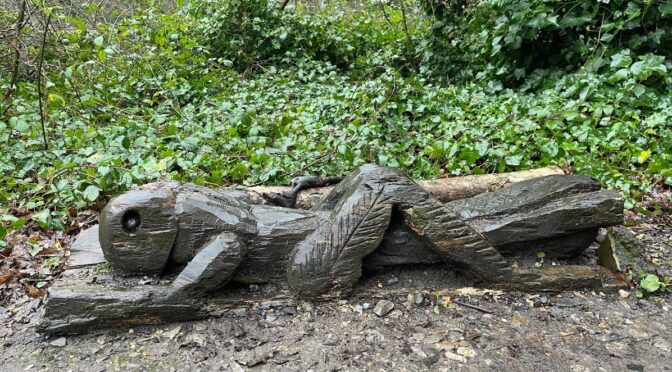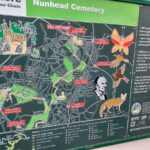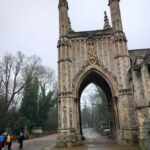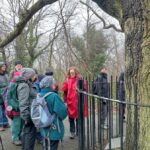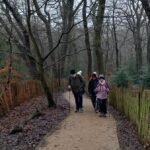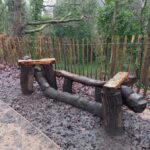An impressive total of 18 assembled at Crystal Palace station. The weather forecast was overcast and occasional light rain. Unfortunately, this turned out to be pretty accurate and so we only had glimpses of the views the route offers on clear days. The length is about six miles, so is suitable for shorter days in the winter months.
The Crystal Palace building was originally constructed for the Great Exhibition of 1851 which was in Hyde Park. At the end of the exhibition it was taken down and rebuilt on the current site where it was used until destroyed by fire in 1936. A railway line was built from Nunhead to carry the large number of visitors and the walk follows some of the old route.
The hall was built up on a stonework base which is all that remains. One can still appreciate what a massive building it must have been, the length being nearly 600 metres. The designer, Joseph Paxton, was principally a gardener but he drew on his experience of large green houses. The building was three times the size of St Pauls and had many innovative features. It consisted of largely standardised panels of plate glass in cast iron frames. For the first time in a major structure, standard nuts and bolts were used which hugely simplified construction. The original Exhibition charged for entry, and made a surplus of £25 million over the six month period which was used to found the V&A museum.
Passing the athletics stadium and the amphitheatre we left the park and after some road walking arrived at the attractive Sydenham Wells park, which takes it name from springs used in the 17th century for health cures. In Crescent Wood Road, there’s a substantial house where John Logie Baird stayed during his experiments on an early TV system in the 1920’s.
We dropped down into a cutting, where the old railway emerges from a tunnel. The path is now densely wooded and maintained with a view to encouraging biodiversity. There’s an impressive new footbridge over the former track.
We soon emerged to cross London Road, and enter the Horniman Museum and Gardens. The museum has benefitted from extensive restoration, the restored museum, winning the Art Fund’s museum of the year in 2022. The extensive gardens are grade 2 listed. There’s a smart looking café although there was a considerable queue when we visited. However, there’s a barn with tables where we had our picnics. From the terrace, there’s a view of Dawson’s Heights on a clear day but sadly the group had to take my word for it. This is a large social housing project dating from the 1960’s. Designed by a young architect Kate Macintosh its stepped design was to give many of the flats, views in two directions.
We were soon passing through Camberwell Old Cemetery then a final steep climb to One Tree Hill, Sadly, there was little of the famous view to the north discernible through the cloud. Descending to Camberwell New Cemetery, a level stretch through Victorian terraced housing took us to our Nunhead Cemetery. This is one of the so called Magnificent Seven cemeteries, dating from the 1840’s. They were commercial ventures granted permission by Parliament to relieve pressure on church graveyards that were becoming full. Nunhead was one of the first to open, being built by the same company as Highgate. Just by the entrance there’s an imposing granite obelisk. This was built to commemorate a group of five, known as the Scottish Martyrs, who were sentenced for sedition in 1793 and transported to Australia. The funds were raised by a public campaign in 1851, led by the Radical MP, Joseph Hume. There is a similar monument on Carlton Hill, Edinburgh.
And so to a nice warm train back to London. Thanks to all that came out and made the best of a rather gloomy day, weatherwise.
Mike C
Photos by Gillian and Jackie

